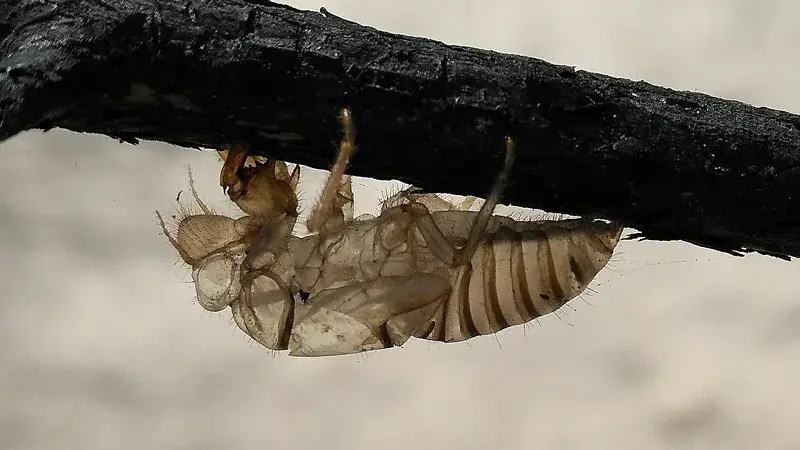
Ghost hanging over the burned ground
by Antonio Jordán, University of Seville, Sevilla, Spain
First in English:
Days after the Doñana fire in 2017, I found this old cuticle of a cicada hanging from the burned branch of a pine tree. It's amazing how after a devastating fire, life goes on.
Many animals, such as arthropods, have an external layer or "skin" called cuticle that is shed in one piece (through a process called ecdysis). During ecdysis, the animal goes through a resting period before shedding its old layer, called exuvia. Since it is not always possible to study insects (or other arthropods) directly, exuviae are useful for identifying the species of the animal.
After this process, the animal has a new layer that is soft and pale in color, and it is called teneral. It takes some time, usually a few hours, for it to harden and acquire its normal color. Although they can molt at various times throughout their lives, they typically stop doing so when they reach adulthood (imago), and therefore, they can no longer grow further.
The exuvia, as the former exoskeleton of the insect, is mainly composed of chitin, along with other substances like calcium carbonate or proteins. Chitin is a polysaccharide (a chain of sugars) very similar to cellulose. Unlike other animals, arthropods can feed on exuviae (their own or from another individual), which serves as a source of energy. Chitin is the second most abundant polymer in nature after cellulose, and therefore an important intermediate in the carbon cycle.
Ahora, en español:
Días después del incendio de Doñana en 2017, encontré esta cutícula de cigarra colgando de la rama quemada de un pino. Es sorprendente cómo después de un incendio desolador, la vida sigue.
Muchos animales, como los artrópodos, tienen una capa externa o "piel" llamada cutícula que se cambia de una vez (mediante un proceso llamado ecdisis). Durante la ecdisis, el animal pasa por un período de reposo antes de desprenderse de su antigua capa, exuvia. Como no siempre es posible estudiar insectos (u otros artópodos) directamente, las exuvias son útiles para identificar la especie del animal.
Después de este proceso, el animal tiene una nueva capa que es suave y de color pálido, y se le llama teneral. Luego, tarda un tiempo, generalmente unas horas, en endurecerse y adquirir su color normal. Aunque pueden cambiar de piel en varios momentos a lo largo de su vida, normalmente dejan de hacerlo al llegar a su etapa adulta (imago) y, por lo tanto, ya no pueden crecer más.
La exuvia, como antiguo exoesqueleto del insecto, está formada mayoritariamente por quitina, además de otras sustancias (como carbonato de calcio o proteínas). La quitina es un polisacárido (una cadena de azúcares) muy parecida a la celulosa. A diferencia de otros animales, los artópodos pueden alimentarse con la exuvia (propia o de otro individuo), que constituye una fuente de energía. La quitina es el segundo polímero más abundante en la naturaleza después de la celulosa y, por lo tanto, un intermediario importante en el ciclo del carbono.
Categories
Location
- Europe (3893)
- Southern Europe (1691)
- Spain (819)
- Exact location (-6.6544 W, 37.0674 N)
Tags
Colours
Image properties
1841 × 1036 px;
image/jpeg; 464.9 KB
Camera:
Huawei HUAWEI MLA-L01
Taken on 6
July
2017
Submitted on 4 June 2018
Licence
Creative Commons Attribution-ShareAlike 3.0 Unported (CC BY-SA 3.0)
Credit
Antonio Jordán (distributed via imaggeo.egu.eu)
Share
Appreciate
Report